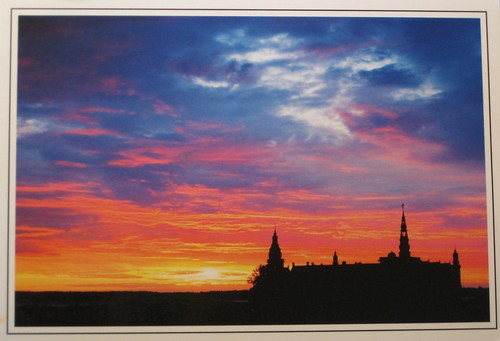
Kronborg Castle in Helsingør.
I recently returned from a long trip to Europe. I spent the most time in Denmark, visiting a dear friend. Denmark is a pretty small country, and I think I hit most of the major tourist destinations, so I'll be posting cards of more of them later on. Helsingør is about an hour north of Copenhagen by train, in the northeast part of the island of Zealand. At the narrowest point of the Øresund (channel between Denmark and Sweden), it guards the entrance to the Baltic Sea. In fact, this was the purpose of the castle: to collect sound dues from all ships entering or leaving the Baltic, and to open fire on any ship that refused. Sound dues were established by King Eric VII in 1429, at which time the castle was a military fortress. It wasn't until Frederick II came into power in the late 1500s that it took on the form of a "magnificent renaissance castle." Over the years, Kronborg was destroyed by fire, rebuilt, captured by Sweden (and most of the royal treasures stolen, although the Swedes have thoughtfully loaned Frederick II's royal canopy back to the Kronborg museum), a dungeon for convicts, and military barracks. Sound dues were abolished in 1857, and now the castle and its grounds, a UNESCO world heritage site, are open to the visiting public.
Helsingør is more famously known as Elsinore, the setting for Shakespeare's "Hamlet." My friend's roommate, upon my return, said "You know that Hamlet didn't actually live there, right?" Well, yes, being a fictional character and all... (however, there is an abbey in Helsingør which boasts "Hamlet's grave" -- apparently so many tourists wanted to visit Hamlet's grave that they decided to create one!) Every summer there's a Hamlet festival where they perform the play on the castle grounds. Unfortunately I was 2 days too late to see it.
Two stamps of 2012 featuring illustrations of stories by Hans Christian Andersen. On top is "Hvad fatter gør, det er altid det rigtige" ("What The Old Man Does Is Always Right") and on the bottom is "De vilde svaner"("The Wild Swans").

No comments:
Post a Comment